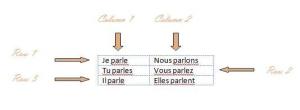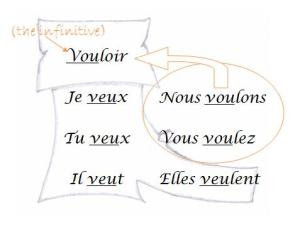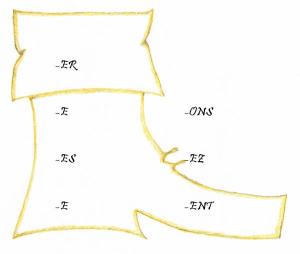If you’ve spent any time studying French in a formal setting, you’ve worked on verb conjugation drills. They’re not fun, but verb conjugation is incredibly important and one way to learn it is to drill it.
Hopefully, your teacher and your textbook always arrange your verbs like this:
| Je parle |
Nous parlons |
| Tu parles |
Vous parlez |
| Il parle |
Ils parlent |
Teachers do this because writing them out in one straight list takes up too much room on the page.
No.
There’s actually a very good reason to write out verbs like this, and if this is not how you study your verbs – you should start. There is a logical pattern to this two-column layout and whether you know it or not, your brain likes logic. Take a moment to look back and see if you can figure out the pattern.
Did you look back? Because you are much more likely to learn, understand, and remember if you try to figure it out yourself before you’re just given the answer. Seriously, take all the time you want – the answer isn’t going anywhere. When you think you see at least one pattern – look at the answer below the following chart. (Here’s a clue for you – there’s one rule for each column and one for each row.)

The rows are all about the “grammatical person”. If we were talking about literature, we would call this the “narrative mode”. Row one is the “first person”. Row two is the “second person”. Row three is the “third person”.
In row one, the speaker is talking about himself or herself:
-“I am colorless and green.”
-“We got stuck on top of the Eiffel Tower.”
In row two, the speaker is addressing someone else:
-“You sleep furiously.”
-“Y’all say funny things.”
In row three, the speaker is talking about someone else:
-“She is colorless and green!”
-“They eat snails.”
Aside from just being kind of cool, this layout makes one common recurring pattern in French conjugation very clear – the Boot. There are a lot of verbs in French and there are several tenses and moods – you do not want to have to memorize them all. This is why patterns are so important. It is way better to learn one consistent pattern than 50 separate verb conjugations.
When a verb is what we call a “boot verb” it follows one pattern for the “je”, “tu”, “il/elle”, and “ils/elles” conjugations and a different pattern for the “nous” and “vous” conjugations. So you will have two patterns – one inside the boot and one outside. The pattern outside the boot usually closely resembles the infinitve. “Vouloir” is an excellent example of a boot verb:

If you struggle with verb conjugation, books like the ubiquitous 501 French Verbs can be very helpful. (You’ll notice that 501 French Verbs arranges the conjugations the same way I do.) However, it is important to remember to use books like this only to look up completely new and unfamiliar verbs or to verify verbs you’re not sure of. Don’t use them as a crutch – as the first place you look when you need to conjugate a verb. This will only make it harder for you to speak and write with any fluency – trust me, I learned this lesson the hard way. Use your brain first, and turn to outside resources second.
can be very helpful. (You’ll notice that 501 French Verbs arranges the conjugations the same way I do.) However, it is important to remember to use books like this only to look up completely new and unfamiliar verbs or to verify verbs you’re not sure of. Don’t use them as a crutch – as the first place you look when you need to conjugate a verb. This will only make it harder for you to speak and write with any fluency – trust me, I learned this lesson the hard way. Use your brain first, and turn to outside resources second.
http://rcm.amazon.com/e/cm?lt1=_blank&bc1=FFFFFF&IS2=1&npa=1&bg1=FFFFFF&fc1=000000&lc1=DB8D11&t=aegtra-20&o=1&p=8&l=as1&m=amazon&f=ifr&md=10FE9736YVPPT7A0FBG2&asins=0764179837



